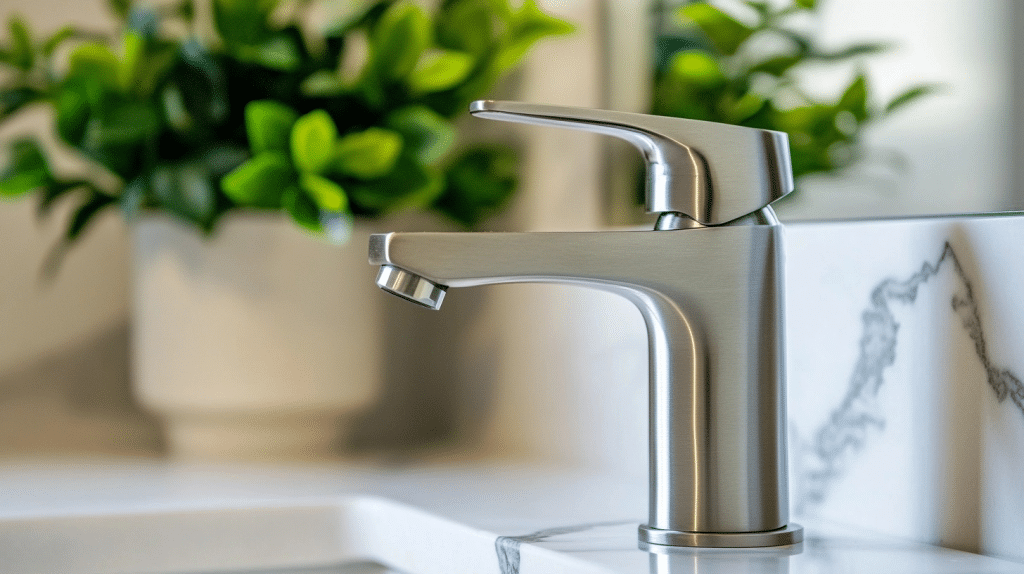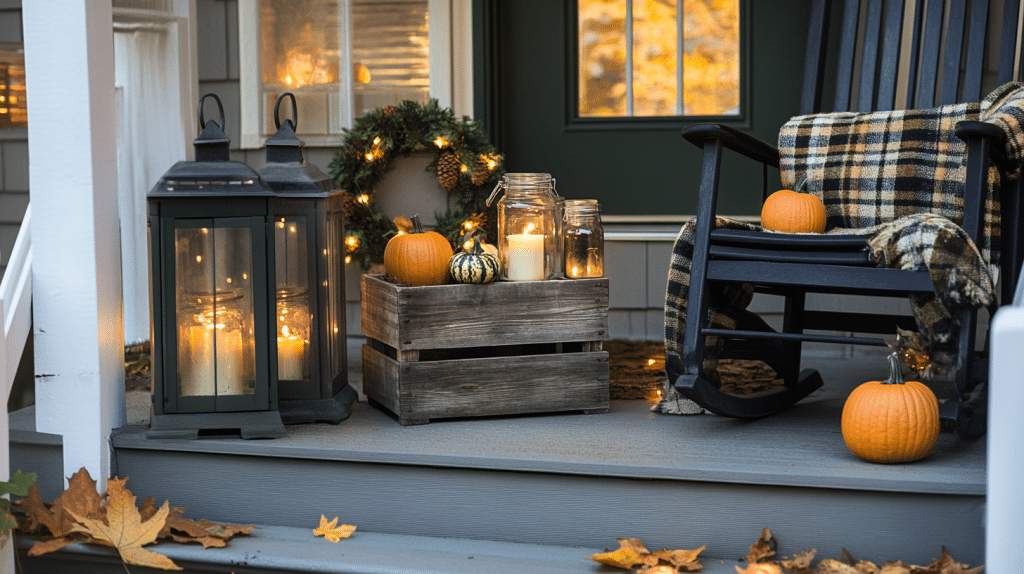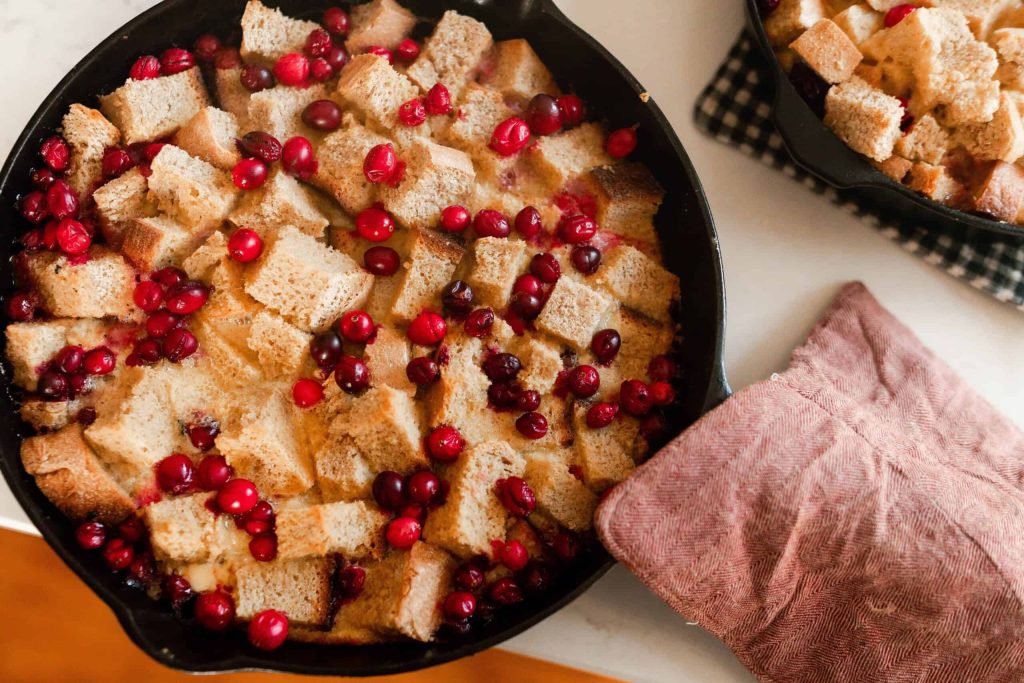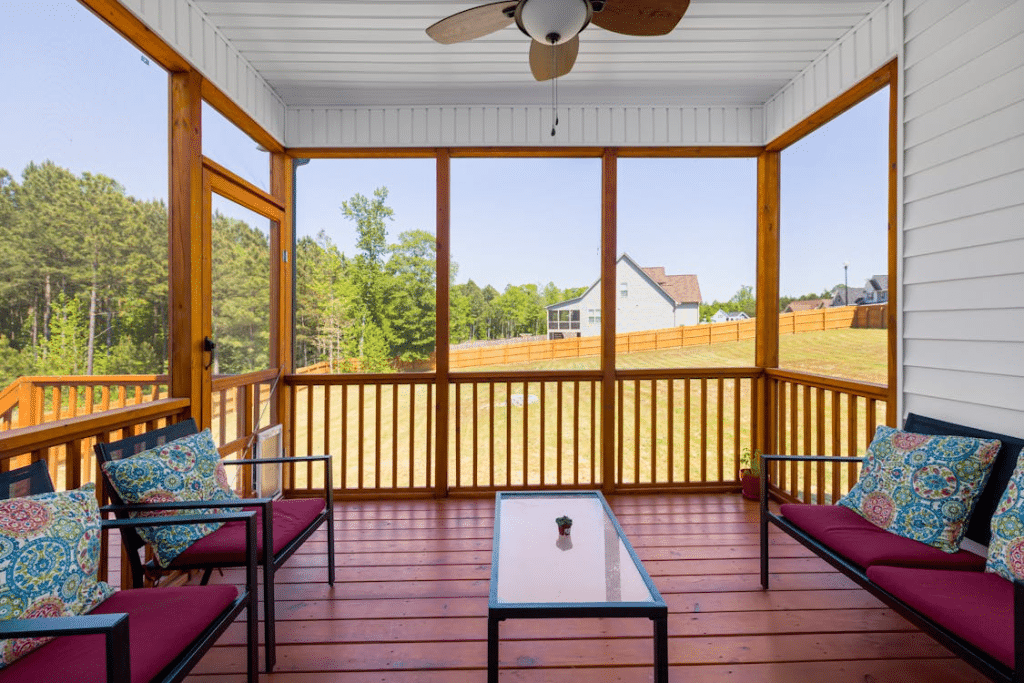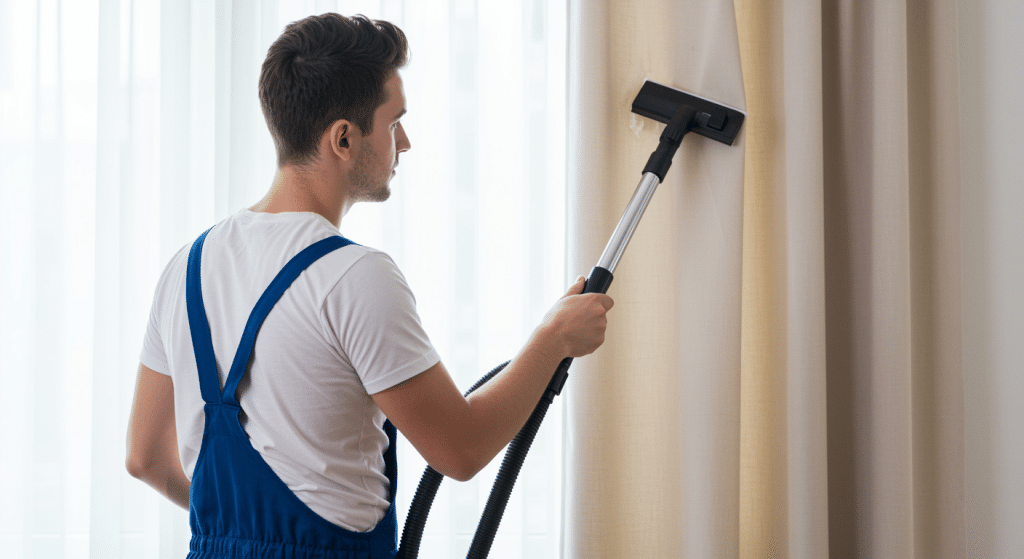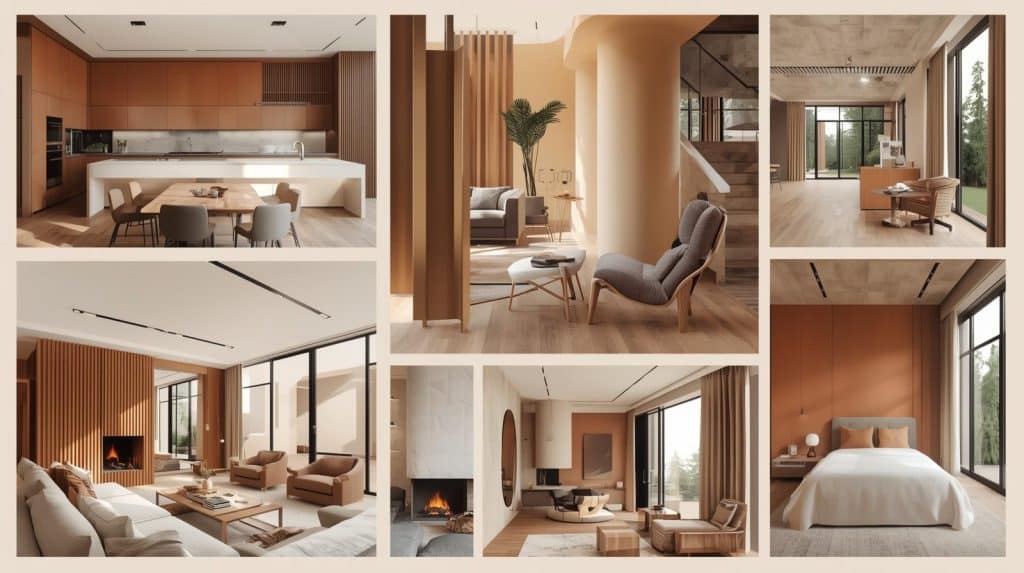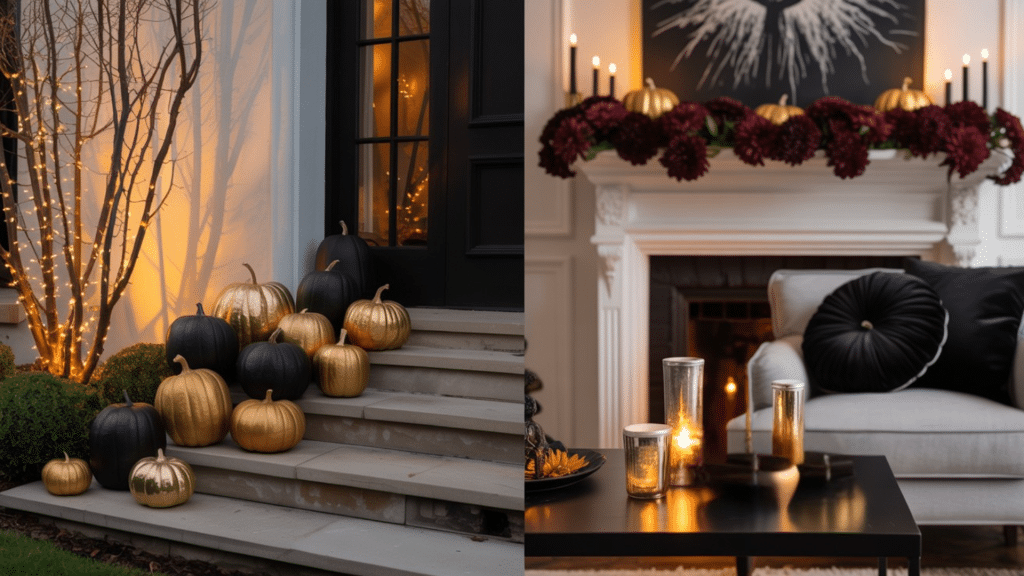I remember standing in a hardware store, staring at rows of drawer pulls labeled “brushed nickel,” wondering why they all looked slightly different.
If you’ve ever found yourself questioning metal finishes, you’re not alone.
Brushed nickel has become a go-to choice for homeowners, offering a mix of style and practicality. It blends effortlessly into different spaces, but what sets it apart from other finishes?
In this guide, I’ll break down everything you need to know about brushed nickel, its true color, how it compares to other finishes, and whether it’s the right fit for your home.
By the end, you’ll have a clear idea of whether this finish aligns with your style and needs.
What is Brushed Nickel?
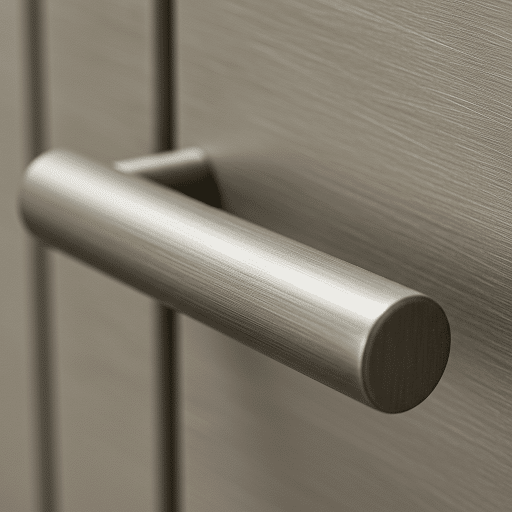
Brushed nickel isn’t just a color, it’s a metal treatment that gives a distinct, clean look. You’ve probably seen it everywhere, from kitchen faucets to door handles.
It’s made by taking nickel-plated metal and brushing it with fine abrasives, creating tiny linear marks that diffuse light and give it a soft, matte finish.
The result? A silvery-gray tone with warm undertones that feels stylish without being too flashy. Walk into any home improvement store, and you’ll find it on faucets, cabinet handles, and light fixtures.
It’s a favorite because it blends modern and classic styles while also being great at hiding fingerprints and water spots.
What Color Is Brushed Nickel?
Brushed nickel is best described as a warm silver with a muted, matte texture. Unlike shinier finishes, it features a soft grayish tone with subtle brownish undertones that give it warmth and depth.
The mechanical brushing process creates microscopic grooves that diffuse light softly, rather than reflecting it sharply like polished surfaces.
What truly distinguishes brushed nickel is its warmth factor. While chrome and polished silver can feel sterile or industrial, brushed nickel brings a subtle, inviting warmth to spaces.
Its satin finish (typically 21-35 gloss units) strikes that perfect balance between completely flat and overly shiny, adding depth without overpowering the space.
In my experience comparing different manufacturers, brushed nickel can vary slightly in appearance. Some versions lean toward cooler gray undertones, while others adopt a warmer champagne-like quality.
When viewed in natural daylight, brushed nickel reveals its true character, a refined neutral that complements both cool and warm color schemes effortlessly. This remarkable adaptability explains why it has become such a popular choice in modern homes.
How Brushed Nickel Appears in Different Lighting
One of the most fascinating aspects of brushed nickel is how it changes under different lighting conditions. If you’ve ever wondered, what color is brushed nickel? the answer depends on the lighting around it. This chameleon-like finish adapts throughout the day in various homes:
- Under Natural Ligh: Brushed nickel takes on a warmer glow with subtle brownish undertones, creating a soft, inviting presence that complements wood tones.
- With Artificial Lighting: Responds differently to various light sources: cool-toned LED lights bring out its silvery qualities, while incandescent bulbs enhance its warmth.
- During Evening Hours: Its non-reflective surface softens the ambiance, minimizing harsh glare in low-light situations, perfect for bedrooms and living areas.
- In Bright Spaces: Maintains its subtle, muted luster without becoming overwhelming or creating distracting reflections.
- With Accent Lighting: When spotlighted, brushed nickel develops a dimensional quality, adding subtle depth to hardware and fixtures.
This lighting versatility is one of brushed nickel’s hidden strengths. Its ability to shift subtly under different conditions makes it an adaptable and timeless choice.
Is Brushed Nickel Worth It? Pros and Cons to Consider
If you’re wondering whether brushed nickel is worth the investment, the answer depends on what you value most in a finish. Having worked with brushed nickel in so many homes, I’ve come to appreciate its charm, though, like anything, it has its ups and downs. Let’s break it down.
Pros
- Incredibly versatile: Whether your style is modern, rustic, or traditional, it blends in seamlessly.
- Low-maintenance: The brushed texture naturally conceals fingerprints and smudges, making upkeep a breeze.
- Moisture-resistant: Holds up well in bathrooms and kitchens, thanks to its resistance to water spots.
- Highly durable: Even after years of wear and tear, it retains its appeal.
- Creates a softer ambiance: Since it isn’t overly reflective, it diffuses light gently, avoiding harsh glare.
- Timeless appeal: Unlike trend-driven finishes, brushed nickel remains a classic choice that doesn’t feel outdated.
Cons
- Not entirely scratch-proof: With heavy use, minor surface wear can develop over time.
- Lacks a high-gloss finish: If you prefer a sleek, mirror-like shine, polished chrome might be a better option.
- Slightly higher price point: While not the most expensive finish, it can cost more than basic alternatives.
- Subtle rather than bold: If you’re after a dramatic statement, finishes like matte black or copper stand out more.
- Textured surface requires occasional deep cleaning: While it hides smudges well, dirt can settle into the fine grooves over time.
At the end of the day, brushed nickel balances practicality and versatility. If it’s the right choice depends on your preferences and lifestyle.
Comparing Brushed Nickel With Other Finishes
Having installed hundreds of fixtures in client homes, I’ve witnessed firsthand how different metal finishes perform in real-world conditions.
Here’s my comparison based on years of experience:
| Finish | Appearance | Key Features | Best For |
|---|---|---|---|
| Brushed Nickel | Warm silver with matte texture | Fingerprint-resistant, subtle warmth, diffused reflection | Versatile spaces, busy households, timeless designs |
| Satin Nickel | Smooth, low-luster nickel with less texture | Slightly more sheen than brushed, warmer undertones, elegant look | Upscale bathrooms, sophisticated spaces, refined designs |
| Polished Nickel | Reflective silver with warm undertones | More reflective than brushed, warmer than chrome, elegant shine | Luxury spaces, formal rooms, traditional interiors |
| Chrome | Bright, mirror-like silver | Highly reflective, cool undertones, dramatic shine | Modern spaces, small rooms needing visual expansion, budget-friendly projects |
| Brushed Chrome | Muted silver with cool undertones | Less reflective than chrome, cooler than brushed nickel, industrial feel | Contemporary designs, commercial-inspired spaces, sleek interiors |
| Stainless Steel | Cool metallic with slight sheen | Durable, industrial feel, cooler than brushed nickel | Contemporary kitchens, commercial-inspired spaces, industrial designs |
Brushed Nickel vs. Satin Nickel
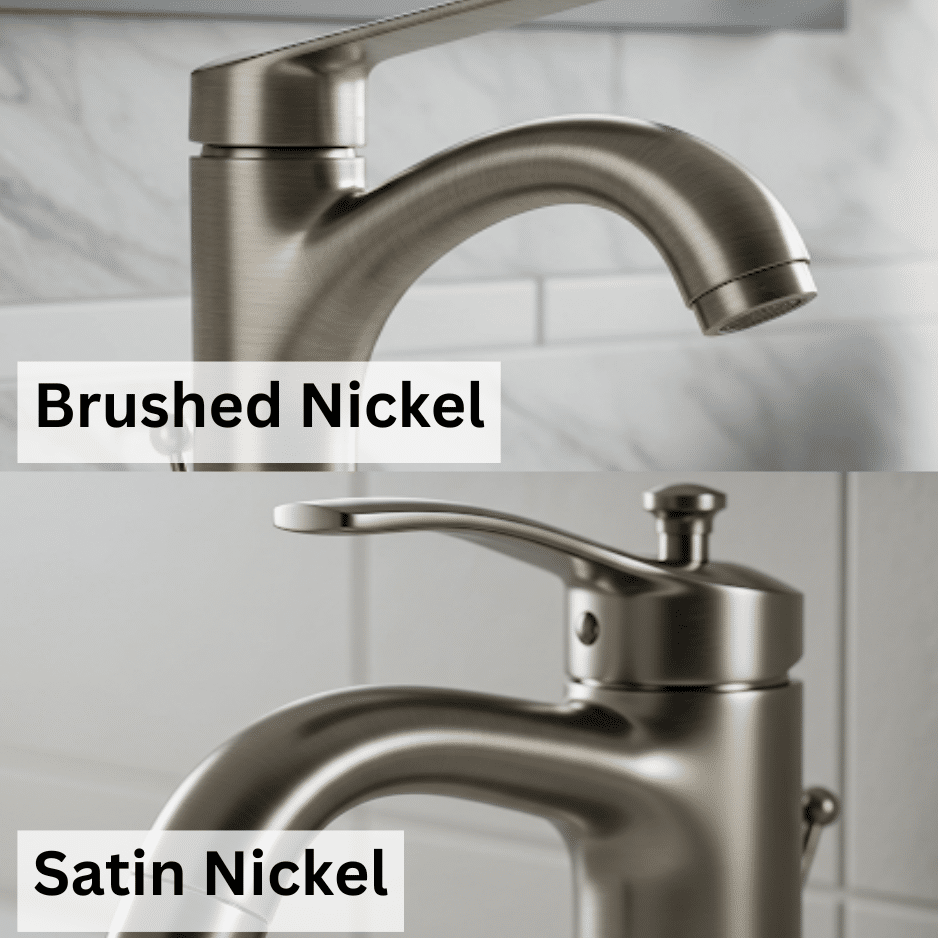
While these terms are sometimes used interchangeably, I’ve found satin nickel typically has a smoother finish with less visible brushing.
Satin nickel offers slightly more sheen and tends to appear a touch more formal than brushed nickel. I recommend brushed nickel for busy family spaces, while satin nickel creates a more refined look in guest bathrooms or formal living areas.
Brushed Nickel vs. Polished Nickel
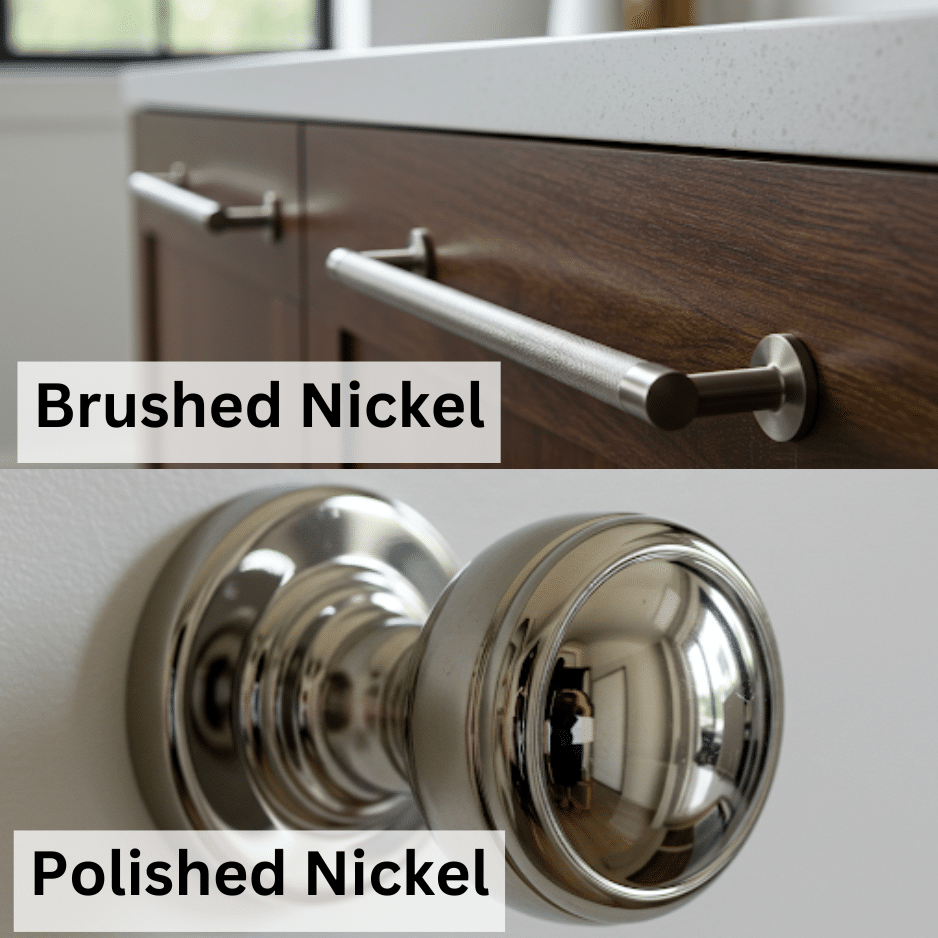
The main difference I point out to clients is the reflection level. Polished nickel has that elegant mirror finish but shows every fingerprint, while brushed nickel forgives daily use.
Polished nickel also has warmer undertones that can complement gold accents beautifully. If you want understated reliability, go brushed; for sophisticated shine, choose polished.
Brushed Nickel vs. Chrome
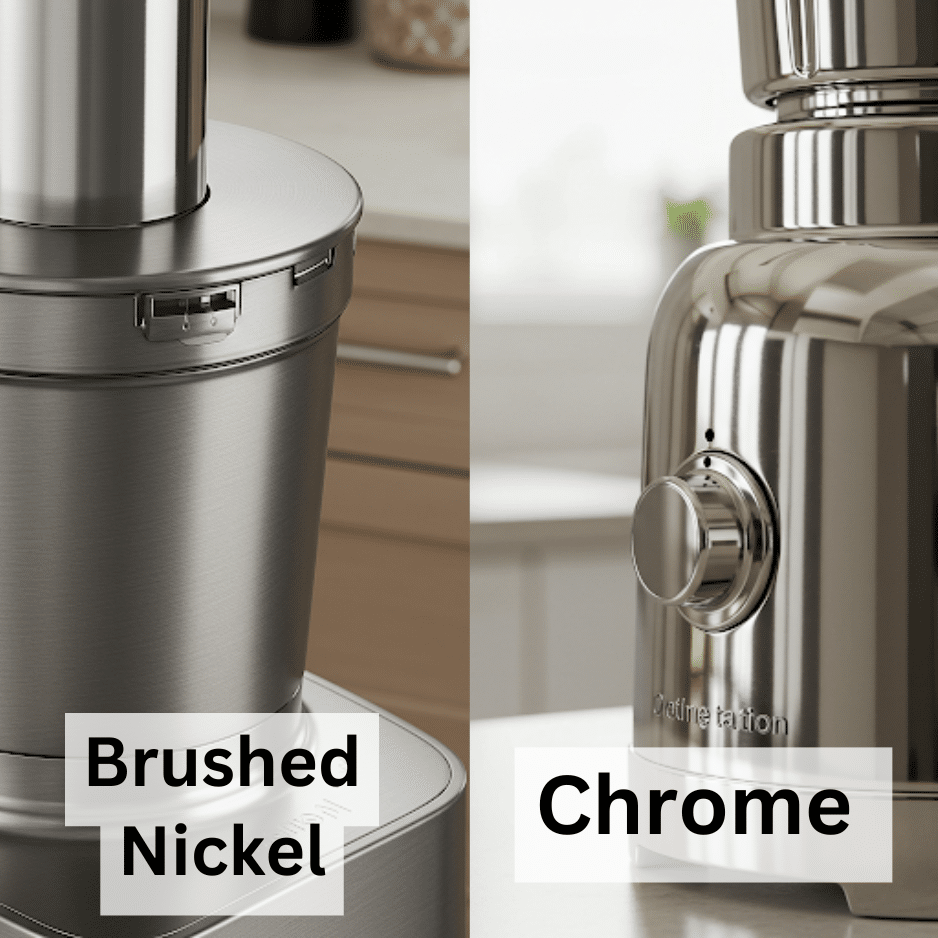
Chrome delivers high shine at a lower price point, making it budget-friendly, but it’s a fingerprint magnet compared to brushed nickel. I’ve found chrome works wonderfully in smaller spaces where its reflective quality makes rooms feel larger, while brushed nickel creates a more subdued, consistent look throughout larger homes.
Brushed Nickel vs. Brushed Chrome
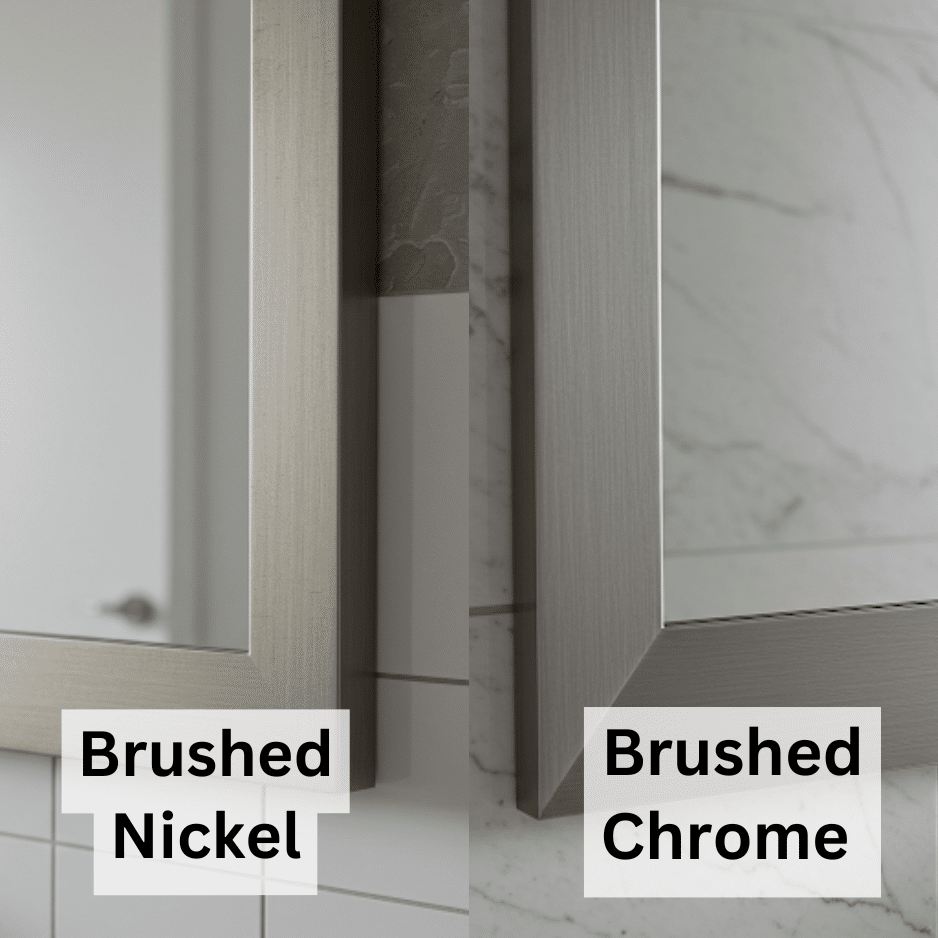
The distinction here comes down to temperature. Brushed chrome has distinctly cooler undertones than the warmer brushed nickel.
In modern, cool-toned interiors, brushed chrome creates cohesion, while brushed nickel adds subtle warmth to both cool and warm color schemes. Brushed nickel tends to be more versatile across diverse styles.
Brushed Nickel vs. Stainless Steel
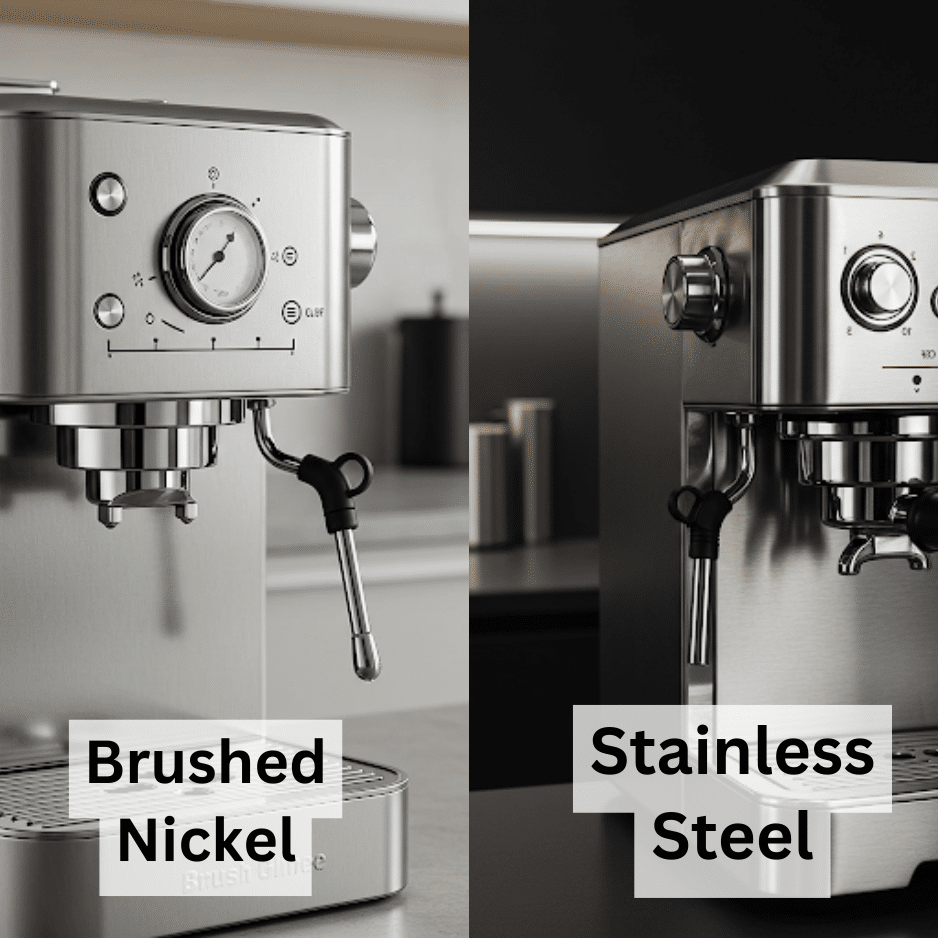
Though similar at first glance, stainless steel has a cooler, more industrial feel compared to brushed nickel’s warmer presence.
I typically recommend stainless steel for contemporary kitchens with appliance matching concerns, while brushed nickel offers greater versatility throughout the home and pairs more easily with a range of wood tones.
Where to Use Brushed Nickel for Maximum Impact
After specifying finishes for hundreds of residential and commercial projects, I’ve identified the spaces where brushed nickel truly shines. This versatile finish delivers both classic appeal and practical benefits when strategically placed.
Brushed nickel offers practical and stylish solutions for various spaces:
- High-Touch Surfaces: Resists fingerprints and water spots better than chrome or polished finishes.
- Lighting Fixtures: Creates a soft, diffused reflection for ambiance without harsh glare.
- Transitional Spaces: Ensures cohesion between rooms with different styles.
- Family Bathrooms: Combines moisture resistance with easy maintenance.
- Kitchens with Mixed Materials: Pairs well with both stone countertops and wood cabinetry.
- Minimalist Designs: Adds subtle refinement without overpowering the space.
- Maximalist Spaces: Acts as a grounding neutral, balancing bold patterns.
Brushed Nickel Care: How to Keep It Looking Like New
I’ve maintained numerous brushed nickel fixtures over the years, and I can tell you from experience that this finish is remarkably forgiving, but a little care goes a long way.
With the right maintenance routine, your brushed nickel can retain its classy charm for decades without developing unsightly spotting or discoloration.
- Daily Cleaning: Simply wipe surfaces with a soft, damp microfiber cloth to remove water spots and fingerprints—this quick habit prevents buildup that can become harder to remove later
- Weekly Maintenance: Use mild dish soap diluted in warm water for more thorough cleaning, avoiding harsh products containing ammonia, bleach, or abrasive ingredients that can damage the finish
- Stubborn Stains: For water deposits or soap scum, try a 50/50 solution of white vinegar and water, applying it briefly with a soft cloth before rinsing thoroughly.
- Buffing Technique: Every few months, give fixtures a gentle buff with a dry microfiber cloth following the grain of the brushed finish to restore luster without scratching
- Protective Measures: Consider applying a thin coat of carnauba wax once or twice yearly to create a protective barrier against moisture and fingerprints
- Prevention Tips: Use coasters under cups in bathrooms, wipe down faucets after use, and encourage family members to dry handles with a towel after washing hands
- What to Avoid: Never use steel wool, abrasive sponges, or acidic cleaners that can permanently damage or discolor the brushed texture.
The Bottom Line
Now that you know what brushed nickel is, where it works best, how it compares to other finishes, and how to maintain it, you can see why it’s such a reliable choice.
Its subtle style blends effortlessly with different styles without overpowering a space. Having installed it in countless homes, I can confidently say that brushed nickel remains one of the most versatile and low-maintenance finishes available.
It resists fingerprints, maintains its appeal over time, and complements a wide range of interiors.
If you appreciate a finish that balances style and practicality, brushed nickel is definitely worth considering.
Have you used brushed nickel in your home? Share your experience in the comments! And if this guide helped you, feel free to pass it along to a friend making their own hardware choices.


